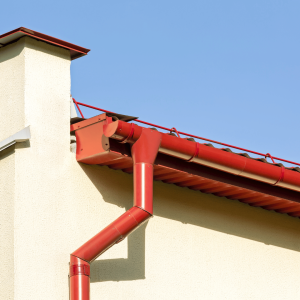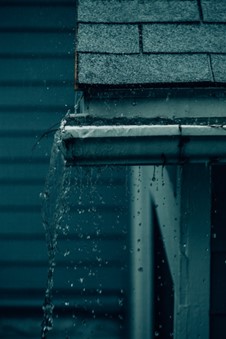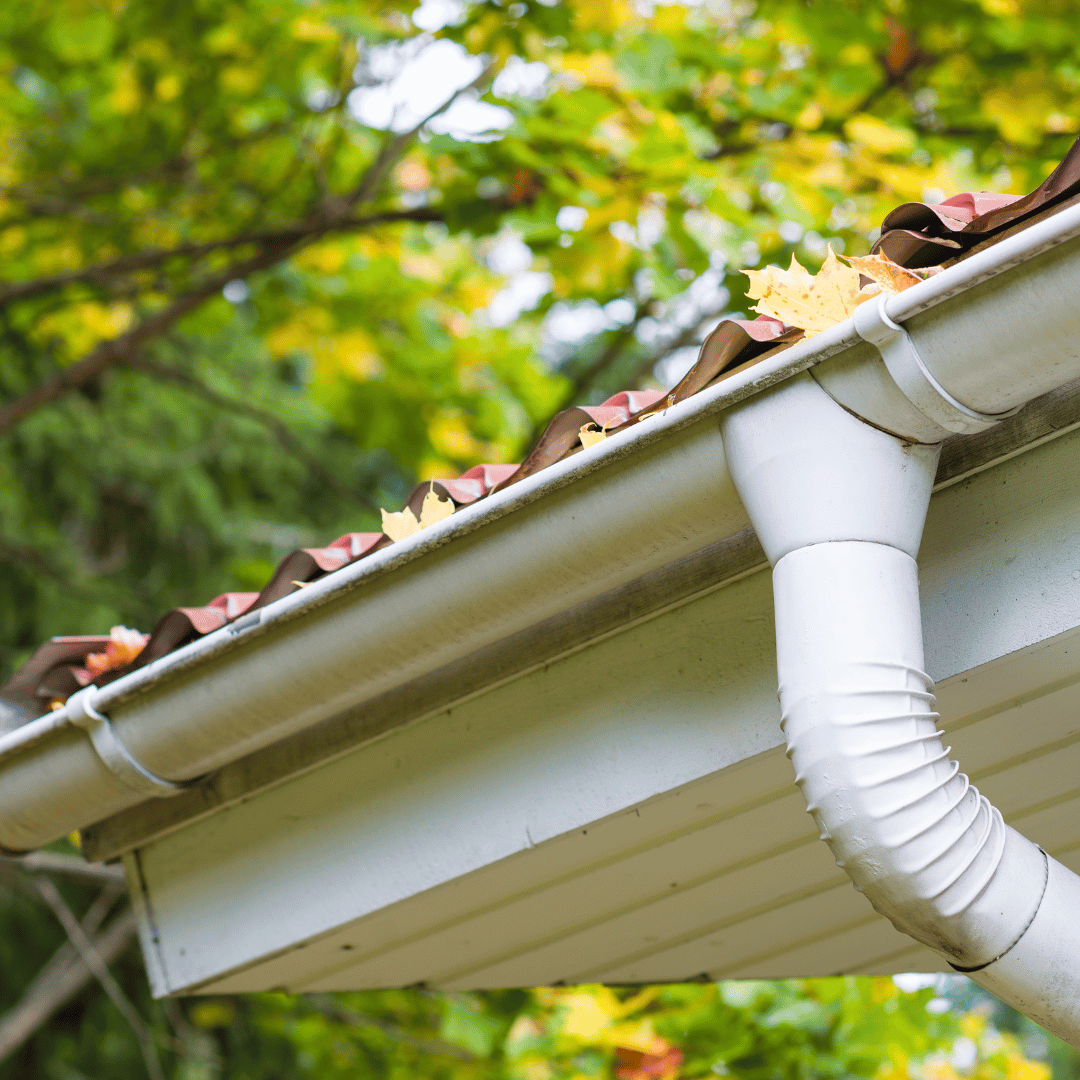
Understanding the Different Types of Gutter Downspouts
Gutter downspouts are essential components of any home’s drainage system, directing rainwater away from the roof and foundation to prevent water damage. Understanding the various types of downspouts and their functions is crucial for effective exterior home maintenance. At HomeSmiles, we believe that maintaining your home’s integrity starts with being informed about the systems that protect it.
In this article, we will explore the different types of gutter downspouts, clarify the difference between gutter drains and downspouts, and answer common questions related to downspout sizing and designations. Regular maintenance, including gutter cleaning and inspections, is a fundamental part of our extensive 18-point interior and exterior home maintenance service. By staying proactive, you can avoid costly repairs down the line and ensure that your home remains safe and dry. Let’s dive into the various types of downspouts and their significance in maintaining your property.
What Are the Different Types of Downspouts?
When it comes to gutter downspouts, there are several types to consider, each with its own unique advantages and applications. Here’s a breakdown of the most common types of downspouts:
1. Round Downspouts
- Description: Round downspouts are cylindrical and often made from materials like aluminum or PVC. They have a sleek, modern look and are commonly used in residential settings.
- Advantages:
- Easy to install and maintain.
- Less likely to clog due to their smooth interior surface.
2. Square Downspouts
- Description: Square downspouts feature a square or rectangular cross-section. They are typically made from metal or vinyl and can complement traditional architectural styles.
- Advantages:
- Offer a contemporary aesthetic that fits well with many home designs.
- Available in various sizes and colors for customization.
3. Rectangular Downspouts
- Description: Similar to square downspouts but with a rectangular shape, these downspouts are often used in commercial buildings or larger homes.
- Advantages:
- Provide higher flow capacity, making them suitable for areas with heavy rainfall.
- Can be easily connected to larger gutter systems.
4. Custom-Made Downspouts
- Description: Custom-made downspouts are designed to fit specific architectural features or landscaping requirements. They can be crafted from various materials, including copper, stainless steel, or even painted to match the home.
- Advantages:
- Provide a perfect fit for unique designs or non-standard installations.
- Enhance the overall aesthetic of the home while ensuring efficient water flow.
5. Leader Head Downspouts
- Description: These are specialized downspouts that incorporate a basin or funnel (the leader head) at the top. They help to collect and direct water from multiple gutters into a single downspout.
- Advantages:
- Efficiently manage water from multiple roof areas.
- Reduce the risk of overflow and potential water damage to the foundation.
Understanding the different types of downspouts can help homeowners choose the right option for their specific needs. Whether you’re looking for aesthetics, functionality, or a combination of both, there is a downspout type that can enhance your home’s exterior while effectively managing water drainage. Regular gutter maintenance, including cleaning and inspections, will ensure these systems function properly and protect your home from water damage.
What Is the Difference Between Gutter Drain and Downspout?
Understanding the terminology surrounding your home’s drainage system is crucial for effective maintenance and communication with professionals. While “gutter drain” and “downspout” are often used interchangeably, they refer to different components of the drainage system. Here’s a closer look at each term and their distinctions:
Gutter Drain
- Definition: A gutter drain refers to the entire system that collects and channels rainwater from the roof into a designated drainage area. This system includes gutters, downspouts, and any extensions or channels leading away from the foundation.
- Function: The primary function of a gutter drain is to manage rainwater runoff effectively, preventing water from pooling on the roof or around the foundation, which can lead to water damage and erosion.
- Components:
- Gutters: Horizontal channels installed along the edge of the roof, collecting rainwater as it flows off the roof.
- Downspouts: Vertical pipes that direct the collected water from the gutters down to the ground level.
Downspout
- Definition: A downspout is a specific vertical component of the gutter drain system. It connects to the gutters and directs the water down to the ground or into a drainage system.
- Function: The downspout’s main role is to transport water collected by the gutters safely away from the roof and foundation. Proper functioning of the downspout is crucial to the overall effectiveness of the gutter drain system.
- Variations: As mentioned earlier, downspouts come in various shapes (round, square, rectangular) and can be customized for specific architectural features.
Key Differences
- Scope: The gutter drain encompasses the entire water management system, including gutters, downspouts, and extensions, while the downspout is a single component within that system.
- Functionality: Gutter drains collect and channel water, whereas downspouts specifically direct that water downward and away from the home.
Understanding these distinctions can help homeowners better manage their gutter systems. Regular gutter cleaning and inspections, including checking downspouts for clogs and ensuring they direct water away from the foundation, are essential for maintaining both interior and exterior home maintenance.
What Is the Most Common Size Gutter Downspout?
Choosing the right size downspout is essential for effective water drainage from your gutters. The most common sizes for gutter downspouts are typically either 2×3 inches or 3×4 inches, but various factors can influence the best choice for your home. Here’s a closer look at these common sizes and considerations for selecting the appropriate downspout:
Standard Sizes
- 2×3 Inches:
- Description: This is the smaller of the two standard sizes and is often used in residential settings, especially for homes with average roof areas and rainfall.
- Use Cases: Ideal for standard rainwater management where the volume of runoff is not excessively high.
- Advantages:
- Easier to install and less expensive.
- Aesthetic appeal for smaller homes or those with minimalist designs.
- 3×4 Inches:
- Description: This size is larger and allows for greater water flow, making it suitable for homes with larger roof areas or in regions with heavy rainfall.
- Use Cases: Recommended for larger residential properties or areas that experience significant rainfall.
- Advantages:
- Better capacity to handle heavy downpours and prevent overflow.
- Reduces the risk of water pooling around the foundation, helping maintain structural integrity.
Factors Influencing Size Selection
- Roof Area: Homes with larger roofs tend to collect more rainwater, necessitating larger downspouts to manage the increased volume effectively.
- Rainfall Intensity: If you live in an area prone to heavy rainfall or storms, opting for larger downspouts can help prevent water overflow and drainage issues.
- Gutter Size: The size of your gutters can also influence your downspout choice. Larger gutters typically require correspondingly larger downspouts for optimal performance.
- Local Building Codes: Always check local regulations or building codes, as they may specify minimum requirements for downspout sizes based on environmental conditions.
Conclusion on Size Selection
Selecting the right downspout size is crucial for maintaining the effectiveness of your gutter drainage system. Regular gutter cleaning and inspections, along with proper sizing, play a significant role in preventing water damage to your home. By ensuring that your downspouts can handle the expected rainfall, you can protect both your interior and exterior home maintenance needs effectively.
What Is the Difference Between A and B Downspout?
When it comes to gutter systems, you may encounter references to “A” and “B” downspouts. Understanding these classifications can help you make informed decisions about your home’s drainage system. Here’s a detailed breakdown of the differences between A and B downspouts, along with their respective applications:
A-Style Downspouts
- Description: A-style downspouts are typically characterized by their larger size and wider opening. They are designed to handle higher volumes of water, making them suitable for areas with heavy rainfall.
- Features:
- Usually rectangular or square in shape.
- Often used in commercial buildings or larger residential properties where significant water drainage is required.
- Advantages:
- Better flow capacity, reducing the risk of overflow during heavy rains.
- More efficient in directing water away from the foundation, thereby minimizing potential water damage.
B-Style Downspouts
- Description: B-style downspouts are smaller and often used in standard residential applications. They are designed for homes that do not experience excessive rainfall and have smaller roof areas.
- Features:
- Generally round or square in shape, with a narrower opening compared to A-style downspouts.
- Commonly found in smaller homes or in regions with moderate rainfall.
- Advantages:
- Cost-effective due to their smaller size and reduced material requirements.
- Easier to install, making them a popular choice for standard residential gutter systems.
Key Differences
- Size and Capacity: The primary difference lies in their size and water handling capacity, with A-style downspouts designed for heavier loads compared to B-style downspouts.
- Application: A-style downspouts are ideal for larger properties or areas with high rainfall, while B-style downspouts are sufficient for smaller homes with less drainage needs.
Choosing Between A and B Downspouts
Selecting the right type of downspout depends on various factors, including:
- Roof Area: Homes with larger roof areas may benefit from A-style downspouts to manage increased water flow effectively.
- Rainfall Patterns: If you live in a region prone to heavy rains, A-style downspouts can provide better performance and reduce the risk of overflow.
- Aesthetic Considerations: The choice between A and B styles may also be influenced by the overall design of your home and personal preferences.
Understanding the differences between A and B downspouts can guide you in selecting the right option for your home’s gutter system. Regular maintenance, including gutter cleaning and inspections, will ensure that your chosen downspouts function efficiently, protecting both your home’s interior and exterior from potential water damage.
What Do A and B Mean in Gutters?
In the context of gutters and downspouts, the terms “A” and “B” refer to specific styles and measurements that help categorize the components used in a home’s drainage system. Understanding what these classifications mean can aid in selecting the appropriate materials and configurations for your gutter system. Here’s a closer look at what A and B represent in the world of gutters:
A-Style Gutters
- Definition: A-style gutters are generally wider and designed to handle larger volumes of rainwater. The “A” designation typically corresponds to their capacity and suitability for high-flow applications.
- Characteristics:
- Often rectangular or square in shape.
- More robust construction, allowing for greater water collection.
- Commonly used in areas that experience heavy rainfall or on larger residential and commercial properties.
- Benefits:
- Reduced risk of overflow during heavy rain events.
- Effective in directing water away from the home, protecting foundations and landscaping.
B-Style Gutters
- Definition: B-style gutters, on the other hand, are designed for standard residential applications and typically have a smaller capacity compared to A-style gutters.
- Characteristics:
- Usually round or smaller rectangular shapes.
- Adequate for homes with average roof areas and rainfall amounts.
- More cost-effective due to their size and simpler installation requirements.
- Benefits:
- Sufficient for areas with moderate rainfall and less risk of water overflow.
- Easier to install and maintain, making them a popular choice for many homeowners.
Practical Implications of A and B Designations
- Installation Considerations: When planning for gutter installation or replacement, understanding the A and B designations helps homeowners choose the right materials and styles based on their specific needs and local weather conditions.
- Maintenance Needs: A-style gutters may require more frequent cleaning and maintenance due to their larger capacity, while B-style gutters might be easier to manage in terms of upkeep.
Choosing the Right Gutter Type
To determine whether A-style or B-style gutters are best for your home, consider the following factors:
- Local Climate: If you live in an area with heavy rainfall, A-style gutters are likely a better choice to handle excess water.
- Roof Size: The size of your roof and the resulting amount of runoff will significantly impact the choice between A and B gutters.
- Aesthetic Preferences: The appearance of your gutter system should complement your home’s design, so consider how each style fits with your overall aesthetic.
Understanding the designations of A and B in gutters can help you make informed decisions for your home’s drainage system. Properly selecting and installing the right type of gutters and downspouts will contribute to effective water management, safeguarding your property from potential damage and ensuring long-lasting performance. Regular gutter cleaning and maintenance will further enhance the efficiency of your chosen system, supporting both your interior and exterior home maintenance goals.
Understanding the various types of gutter downspouts is essential for homeowners looking to maintain their property’s integrity and manage water effectively. From A-style to B-style downspouts, each option offers unique features tailored to specific needs and conditions.
In summary:
- Different Types of Downspouts: Knowing the distinction between A and B downspouts helps in choosing the right option for your home based on size, capacity, and application.
- Gutter Drain vs. Downspout: It’s important to recognize that while gutters collect rainwater, downspouts direct that water away from your home’s foundation, preventing potential damage.
- Common Sizes: Familiarity with standard sizes ensures compatibility with existing systems and efficient water flow management.
- Maintenance Matters: Regular gutter cleaning and inspections are vital to keep your downspouts functioning effectively, avoiding costly repairs down the line.
If you’re ready to ensure your home’s drainage system is in top shape, reach out to HomeSmiles today! Our preventative home maintenance services include comprehensive gutter cleaning and inspections, helping you tackle those “honey-do” tasks and avoid costly repairs. Don’t wait for water damage to occur; contact us now to schedule your maintenance service and keep your home safe and sound!
- Protecting Your Property: Why the Right Cleaning Method Makes All the Difference
- The #1 Thing That’s Dulling Your Curb Appeal (And How to Fix It)
- How Maintenance Bundles Provide Peace of Mind for Busy Small Business Owners and Facility Managers
- Essential vs. Complete Home Packages: Choosing the Right Preventive Care for Your Property
- How a Simplified Service Model Benefits Both Homeowners and Franchisees Alike


